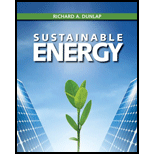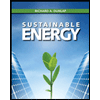
Sustainable Energy
1st Edition
ISBN: 9781133108689
Author: Richard A. Dunlap
Publisher: Cengage Learning
expand_more
expand_more
format_list_bulleted
Concept explainers
Question
Chapter 4, Problem 5P
To determine
Determine the average reduction per square kilometer in
Expert Solution & Answer
Want to see the full answer?
Check out a sample textbook solution
Students have asked these similar questions
1000 th
2' 2'
w=200 to /ft
Handout Problem #3.
A beam has the loading and cross section shown.
1) Draw the shear force and bending moment diagrams
for the beam.
5" 2) Determine the maximum bending stress in the
beam. Carefully identify its location both along the
beam and along the cross section.
3) Determine the maximum transverse shear stress in
the beam. Carefully identify its location both along
the beam and along the cross section:
y=2" up
from bottom
"INA = 33.33 int
VMAX = 1160+b
MMAX - 2704 Hb-ft
QMAX = 8mm³
Units: lb-ft
Handout Problem #2
The dimensions of the shape as well as the bending moment diagram of a flanged wooden shape
are shown. Determine:
(a) the maximum tensile bending stress at any location along the beam and
(b) the maximum compressive bending stress at any location along the beam.
10 in.
10,580
9,200 4,743
2 in.
8 in.
2 in.
2 in.
-8,400
6 in.
(USE 0BC 2024)
For a 800 m2 4-storey sprinklered Dry-cleaning establishment (not using explosive solvents), facing 1 street(s), what are the minimum required fire-resistance ratings (FRR) or fire-protection ratings (FPR) for the following?
Typical floor assembly (in minutes, please. Just write the number of minutes please)
Detailed OBC reference =
Public corridor wall (in minutes please)
Detailed OBC reference =
Suite egress door (in minutes, please) =
Detailed OBC reference =
Exit stair walls (in minutes, please) =
Detailed OBC reference =
Exit stair door (in minutes, please) =
Detailed OBC reference =
Elevator shaft enclosure (in minutes, please) =
Detailed OBC reference =
Vertical mechanical shaft enclosure (in minutes, please) =
Detailed OBC reference =
Knowledge Booster
Learn more about
Need a deep-dive on the concept behind this application? Look no further. Learn more about this topic, civil-engineering and related others by exploring similar questions and additional content below.Similar questions
- Question 6 options: The fourth storey of this "Dry-cleaning establishment (not using flammable solvents)" building measures 41 m x 19 m and has a public corridor. Determine the following dimensions, in millimetres (mm) The minimum width of its ramp, if it is sloped at 6°. Please give your answer to the nearest millimetre. The minimum width of its egress doors for Suite D (measuring 6 m × 4 m, ignored the elevator). Please give your answer to the nearest millimetre. The minimum width of its corridor. Please give your answer to the nearest millimetre. The minimum width of its ramp, if it is sloped at 13°. Please give your answer to the nearest millimetre.arrow_forwardFor the exposing building face marked (XX) of this unsprinklered 'Beauty parlours' building, please determine the following. justify THE answer in your hand-written solution.arrow_forwardIf the angle for the sloped glazing below is 45°, is it considered part of the roof or part of the wall? justify the answer with appropriate and detailed OBC references.arrow_forward
- Determine the state of stress acting at point E. Show the results on a differential elementat this point.arrow_forwardConsider the structure shown in the following figure, which includes two identical towers, a main cable whose unstretched length is 110 m handing between them, and two side cables with negligible weights (so that they can be modeled as massless springs). The side cables are pretentioned so that the net horizontal force on a tower iszero. The mass per unit length of the main cable is 10 kg/m and EAo = 1000KN. Thehorizontal distance between the two towers is 100 m. The angle del is 60°. By design the total horizontal load on each tower is zero. Find A)The horizontal and vertical loads exerted on each tower by the main cable B)The minimum mass M of the counter weights. Note that the counter weights are blocked from moving in the horizontal directionarrow_forward4th Order Rurka-Kutta Method This assignment will expand your skills on using Excel to perform some numerical analyses and plot your results. It is a means to familiarize you more with basic features in the spreadsheet. Preliminaries: a. Start a new file called R-K.xlsx (for this exercise, you may use the work you did in class but please be careful not to delete what you already have) b. Plan ahead Exercise 1: Using the 4" Order Ruga-Kutta Method that we recently learned, evaluate the following ordinary differential equation (ODE): dx f(t, x) = = x+t² dt At the initial position, X= 0, the time is = 0.1 minutes. Using a step size of, h = 0.05, what is the time spent to reach a position that is equal to 17 (Hint: use a O and b 1) Exercise 2 Using the 4th Order Ruga-Kutta Method, solve the following problem: The concentration of a certain non-reactive (conservative) chemical is given as a function of time by: de f(t,c) = = 30-3c Where c is the concentration and t is time. At the initial…arrow_forward
- What percentage of all communication is screened out or changed by the receiver?”arrow_forwardIn testing a certain kind or truck tire over rugged terrain, it is found that 20% of the trucks fail to complete the test run without a blowout. Of the next 13 trucks tested, find the probability that (a) from 2 to 6 have blowouts, (b) fewer than 4 have blowouts, and (c) more than 5 have blowouts. Click here to view page 1 of the table of binomial probability sums. Click here to view page 2 of the table of binomial probability sums. (a) The probability that from 2 to 6 trucks have blowouts is (Round to four decimal places as needed.)arrow_forwardA project requires 125 cubic yards of concrete sidewalk to be placed, for which 165 workhours have been budgeted. The latest weekly progress report shows that 78 cubic yards have been placed and 103 workhours have been expended to date. What is the status of the concrete placement? Significantly under budget. On budget. Significantly over budget. Status cannot be determined with information supplied.arrow_forward
- Refer to exhibit #098. At what depth was water encountered?arrow_forwardWhat is the reaction moment at A for the frame shown? a. 222.1 k-ft b. 107.8 k-ft c. 20.8 k-ft d. 23.25 k-ftarrow_forward“When a conflict exists between the project floor plans and detailed material schedule relative to size or number, which of the following usually governs in typical order of precedence?arrow_forward
arrow_back_ios
SEE MORE QUESTIONS
arrow_forward_ios
Recommended textbooks for you

 Engineering Fundamentals: An Introduction to Engi...Civil EngineeringISBN:9781305084766Author:Saeed MoaveniPublisher:Cengage Learning
Engineering Fundamentals: An Introduction to Engi...Civil EngineeringISBN:9781305084766Author:Saeed MoaveniPublisher:Cengage Learning Solid Waste EngineeringCivil EngineeringISBN:9781305635203Author:Worrell, William A.Publisher:Cengage Learning,
Solid Waste EngineeringCivil EngineeringISBN:9781305635203Author:Worrell, William A.Publisher:Cengage Learning, Sustainable EnergyCivil EngineeringISBN:9781133108689Author:Richard A. DunlapPublisher:Cengage Learning
Sustainable EnergyCivil EngineeringISBN:9781133108689Author:Richard A. DunlapPublisher:Cengage Learning Traffic and Highway EngineeringCivil EngineeringISBN:9781305156241Author:Garber, Nicholas J.Publisher:Cengage Learning
Traffic and Highway EngineeringCivil EngineeringISBN:9781305156241Author:Garber, Nicholas J.Publisher:Cengage Learning


Engineering Fundamentals: An Introduction to Engi...
Civil Engineering
ISBN:9781305084766
Author:Saeed Moaveni
Publisher:Cengage Learning

Solid Waste Engineering
Civil Engineering
ISBN:9781305635203
Author:Worrell, William A.
Publisher:Cengage Learning,

Sustainable Energy
Civil Engineering
ISBN:9781133108689
Author:Richard A. Dunlap
Publisher:Cengage Learning

Traffic and Highway Engineering
Civil Engineering
ISBN:9781305156241
Author:Garber, Nicholas J.
Publisher:Cengage Learning